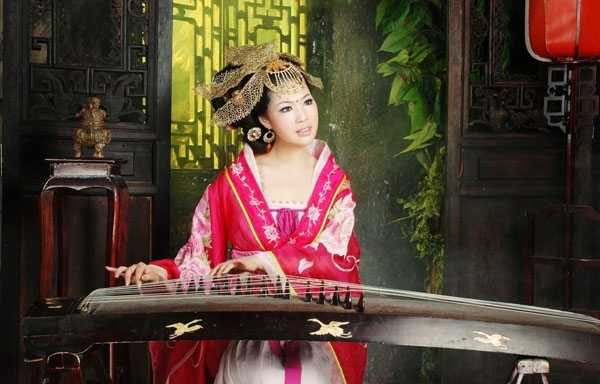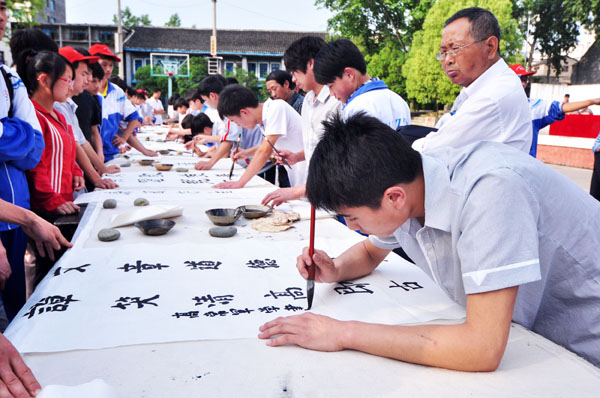Therapies with a musical instrument and chess are the methods to promote somatopsychic health by asking patients to play a musical instrument and chess. The fine movement and coordination of the fingers are under the control of the brain. Thus playing a musical instrument and chess, practicing painting and calligraphy have positive effects on the prevention of cerebral arteriosclerosis, senile dementia, etc. More information about Chinese medicine, please read Chinese medicine Treatment for Impotence.
Playing a musical instrument
Its effects on life cultivation are realized by means of "keeping relaxed and happy" and "exercising fingers to tonify the brain." The single-hearted devotion and the appreciation of peaceful, cheerful and beautiful music during playing a musical instrument make people happy and relaxed. Thus, it has the action of making people have ease of mind and a light heart. Meanwhile, playing a musical instrument can exercise fingers and palms, make them flexible in movements and help finger joints to restore active functions. Playing a musical instrument can be used to eliminate finger dysfunctions such as finger spasm and inflexible finger flexion due to sequelae of apoplexy, flaccidity syndrome, arthralgia syndrome, burn, and injury of muscles and tendons, etc. More information about Chinese medicine, please read TCM Treatment Evaluation for Impotence.

Playing chess
It is a method of life cultivation and rehabilitation to promote intelligence development. When playing chess, people concentrate the mind on the chessboard and get rid of all distracting thoughts. Therefore, playing chess is applicable to people with distractibility and difficulty in concentrating the mind. Besides, playing chess helps to remove depression and have a light heart. It can be applicable to infantile retarded intelligence development and declining intelligence in old people.
Playing chess should be moderate, too. People should not spend too much energy and should not be too particular about the result. The most important aspect is always to while away the time for a light heart and to benefit intelligence. More information about Chinese medicine, please read Prostatic Hyperplasia in TCM.
Therapy with painting and calligraphy
Therapy with painting and calligraphy is a method to promote somatopsychic health by asking the patients to watch and practice painting and calligraphy. People should get rid of distracting thoughts before watching and practicing painting and calligraphy. Then, they regulate breathing and direct qi to fingers, wrists, arms and waist to bring all the force of the body onto the pen point or tip of a writing brush. Actually, this already includes regulation of the mind, breathing and bodily movement. Its mechanism lies in the following aspects. More information about Chinese medicine, please read Causes of Prostatic Hyperplasia in TCM.
Regulating emotions:
Appreciating and practicing painting and calligraphy can mould temperament, soothe and disperse stagnated qi. Therefore, the method is applicable to patients with impetuosity, anger and depression, or patients with disorders of seven emotions. Ancients believed that watching and writing different forms of characters may have different effects on moulding temperament.

(1) Regular script: It has the actions of tranquilizing qi and the mind, removing vexation and impetuosity. Regular script is applicable to diseases due to dysphoria and anger.
(2) Official script: It is imposing and firm, quiet and beautiful, which easily makes people emotionally stable. Official script is also applicable to diseases due to dysphoria and anger. Besides, it is cooperatively used with regular scrip to check activity with tranquility.
(3) Running hand and cursive hand: Both are natural, unrestrained and lively, like floating clouds and flowing water, which can make people in high spirits and have ease of mind. Accordingly, running hand and cursive hand are particularly applicable to patients with depression and pessimism. More information about Chinese medicine, please read Symptoms of Prostatic Hyperplasia in TCM.
Training the body:
When practicing painting and calligraphy, people have fine movements of arms, elbows, wrists and fingers. These fine movements can train general tendons, bones and muscles (especially the upper limbs) to regulate and promote qi flow and blood circulation, relax muscles and tendons and activate collaterals. Practicing painting and calligraphy is used to eliminate dysfunctions and restore functions such as spasm or unsmooth flexion of hands, wrists, elbows and arms due to sequelae of apoplexy, flaccidity syndrome, arthralgia syndrome, burn and injury of muscles and tendons. More information about Chinese medicine, please read TCM Diagnosis for Prostatic Hyperplasia.
Practicing painting and calligraphy can also achieve the purposes of arousing inspiration and improving intelligence by focusing on thinking and cleverly applying fingers. It may be applicable to the rehabilitation of children with hypophrenia, senile amnesia and dementia, etc. Modern researches also indicate practicing painting has satisfactory effects on rehabilitation of feeble-minded children. More information about Chinese medicine, please read Chinese medicine Treatment for Prostatic Hyperplasia.







